Scientists have concluded that the white dwarf WD0810-353 will not pass near the Solar System in 29 thousand years. This conclusion was previously made on the basis of an erroneous estimate of the speed of this star. This was due to the unusual configuration of its magnetic field.

Dangerous White Dwarf
The white dwarf WD0810-353 was once a giant star. It shed its outer shells, leaving only a core with a mass about 8 times less than the solar one. Now this object is 36 light-years away from us.
At the beginning of 2023, scientists published data on the movement of WD0810-353 in space. According to their estimates, the speed of this object was 373.7 km/s. Such a result was strange in itself, but the conclusion that in this case a white dwarf in 29 thousand years would pass from us at a distance of only 0.49 light-years, so 31 thousand AU, was much more striking.
What consequences such an approach could entail — different opinions were expressed. The second Sun would not appear in the sky, because the white dwarf would remain too dim. But the number of comets that would arrive in the inner part of the Solar system could well increase. After all, WD0810-353 would pass through the Oort Cloud, where most of them live.
White dwarf velocity estimates
To make sure that the voiced estimates were correct, the scientists decided to once again check the speed of the WD0810-353. The second team of astronomers got a completely different value — 4200 km/s. However, they immediately guessed that something was wrong here: after all, an ordinary-looking white dwarf could not be one of the fastest stars in the Galaxy.
Scientists suspected that the spectrum of the dwarf distorts something, and therefore its Doppler shift, which determines the speed of stars, may be incorrect. After re-measuring the spectrum of WD0810-353, they came to the conclusion that the speed of this object was only 60-70 km/s.
In both cases, the trajectory of WD0810-353 intersected with the solar one, but this tiny luminary would not fit close to our star. It remained unclear which of the estimates of its speed was correct.
Bizarre magnetic field
And recently, a new study appeared in The Astrophysical Journal. In it the authors found that the speed of WD0810-353 was 83 km/s and this star would not pass through the Oort Cloud. So there’s nothing to worry about.
The culprit in the incorrect estimates of the speed of the star turned out to be a phenomenon known as the blue shift. It consists in the fact that the spectral lines of hydrogen, due to the action of the magnetic field, seem to be shifted towards blue, and this is very similar to the Doppler effect when the star is rapidly approaching us, although in fact this does not happen.
WD0810-353 is the closest strongly magnetized white dwarf to Earth. Its age is 3 billion years and it is moving to the cooling stage. Because of this, its magnetic field has a complex configuration, which distorts the spectrum.
According to www.sciencealert.com.
Follow us on Twitter to get the most interesting space news in time
https://twitter.com/ust_magazine
